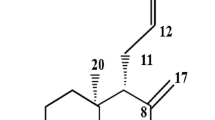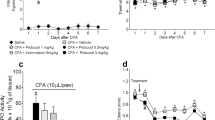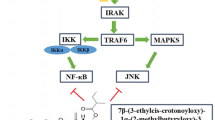Abstract
We investigated the anti-inflammatory activities of argirein and rhein on inflammatory edema in rat paw which was caused by complete adjuvant, compared with ibuprofen. We hypothesized that the adjuvant-induced inflammation is attributed to upregulation of activating transcript factor 6 (ATF6; a chaperone for endoplasmic reticulum (ER) stress), p66Shc (an adaptive protein modulating oxidative stress), and NADPH oxidase subunits p22phox and gp91phox in the inflamed tissues. Biomarkers were measured in the rat paw in association with monitoring swellings. The primary inflammatory edema of the injected paw occurred rapidly and sustained over a couple of days, and the secondary inflammation developed 2 weeks later. The inflammatory edema was accompanied by upregulation of cytokines including ATF6, p66Shc, p22phox, gp91phox, and MMP-2 and an increase in ratio of p-Akt/Akt in the afflicted paw. These were suppressed by either argirein and rhein or ibuprofen. These findings indicate that ER stress, upregulated p66Shc, and phosphorylated Akt are actively implicated in the inflammatory zone caused by adjuvant injection. These biomarkers were causal factors responsible for inflammation of the afflicted paw and were suppressed by a supermolecule argirein and rhein, and the anti-inflammatory activities of the two compounds were comparable to that of ibuprofen.





Similar content being viewed by others
References
Medzhitov, R. 2008. Origin and physiological roles of inflammation. Nature 454: 428–435.
Sweeney, S.E., and G.S. Firestein. 2004. Rheumatoid arthritis: regulation of synovial inflammation. International Journal of Biochemistry and Cell Biology 36: 372–378.
Harirforoosh, S., and F. Jamali. 2009. Renal adverse effects of nonsteroidal anti-inflammatory drugs. Expert Opinion on Drug Safety 8: 669–681.
Sheng, X., M. Wang, M. Lu, B. Xi, H. Sheng, and Y.Q. Zang. 2011. Rhein ameliorates fatty liver disease through negative energy balance, hepatic lipogenic regulation, and immunomodulation in diet-induced obese mice. American Journal of Physiology, Endocrinology and Metabolism 300: E886–E893.
He, Z.H., R. Zhou, M.F. He, C.B. Lau, G.G. Yue, W. Ge, and P.P. But. 2011. Anti-angiogenic effect and mechanism of rhein from Rhizoma Rhei. Phytomedicine 18: 470–478.
Gao, Q., W.S. Qin, Z.H. Jia, J.M. Zheng, C.H. Zeng, L.S. Li, and Z.H. Liu. 2010. Rhein improves renal lesion and ameliorates dyslipidemia in db/db mice with diabetic nephropathy. Planta Medica 76: 27–33.
Zheng, J.M., J.M. Zhu, L.S. Li, and Z.H. Liu. 2008. Rhein reverses the diabetic phenotype of mesangial cells over-expressing the glucose transporter (GLUT1) by inhibiting the hexosamine pathway. British Journal of Pharmacology 153: 1456–1464.
Boileau, C., S.K. Tat, J.P. Pelletier, S. Cheng, and J. Martel-Pelletier. 2008. Diacerein inhibits the synthesis of resorptive enzymes and reduces osteoclastic differentiation/survival in osteoarthritic subchondral bone: a possible mechanism for a protective effect against subchondral bone remodelling. Arthritis Research and Therapy 10: R71.
Pasin, J.S., A.P. Ferreira, A.L. Saraiva, V. Ratzlaff, R. Andrighetto, J. Tomazetti, D.S. Avila, S.H. Alves, M.A. Rubin, J. Ferreira, A.R. Santos, and C.F. Mello. 2010. Diacerein decreases TNF-alpha and IL-1beta levels in peritoneal fluid and prevents Baker’s yeast-induced fever in young rats. Inflammation Research 59: 189–196.
Hu, C., X.D. Cong, D.Z. Dai, Y. Zhang, G.L. Zhang, and Y. Dai. 2011. Argirein alleviates diabetic nephropathy through attenuating NADPH oxidase, Cx43, and PERK in renal tissue. Naunyn-Schmiedebergs Archives of Pharmacology 383: 309–319.
Zhang, G.L., D.Z. Dai, T. Xi, X.D. Cong, Y. Zhang, and Y. Dai. 2011. Isoproterenol-induced FKBP12.6/12 downregulation is modulated by ETA and ETB receptors and reversed by argirhein, a derivative of rhein. Acta Pharmacological Sinica 32: 223–229.
Meyer, D.M., M.I. Jesson, X. Li, M.M. Elrick, C.L. Funckes-Shippy, J.D. Warner, C.J. Gross, M.E. Dowty, S.K. Ramaiah, J.L. Hirsch, M.J. Saabye, J.L. Barks, N. Kishore, and D.L. Morris. 2010. Anti-inflammatory activity and neutrophil reductions mediated by the JAK1/JAK3 inhibitor, CP-690,550, in rat adjuvant-induced arthritis. Journal of inflammation (Lond) 7: 41.
Staron, A., Makosa, G., and Koter-Michalak, M. 2010. Oxidative stress in erythrocytes from patients with rheumatoid arthritis. Rheumatology International doi:10.1007/s00296-010-1611-2.
Yamasaki, S., N. Yagishita, K. Nishioka, and T. Nakajima. 2007. The roles of synoviolin in crosstalk between endoplasmic reticulum stress-induced apoptosis and p53 pathway. Cell Cycle 6: 1319–1323.
Yin, W., A.P. Signore, M. Iwai, G. Cao, Y. Gao, M.J. Johnnides, R.W. Hickey, and J. Chen. 2007. Preconditioning suppresses inflammation in neonatal hypoxic ischemia via Akt activation. Stroke 38: 1017–1024.
Huang, X.L., J. Xu, X.H. Zhang, B.Y. Qiu, L. Peng, M. Zhang, and H.T. Gan. 2011. PI3K/Akt signaling pathway is involved in the pathogenesis of ulcerative colitis. Inflammation Research 60: 727–734.
Dai, D.Z., J. Huang, L. Su, G.H. Shang, H.D. Xu, D.L. Zhang, and X.Q. Huang. 1991. Antiinflammatory effect on six inflammatory models and antipyretic action of N14. Bulletin of the New Drug Research Foundation 1: 5–13.
Feng, Y., Q. Zhang, D.Z. Dai, H.J. Ying, and Y. Dai. 2007. Strontium fructose 1,6-diphosphate rescues adenine-induced male hypogonadism and upregulates the testicular endothelin-1 system. Clinical and Experimental Pharmacology and Physiology 34: 1131–1137.
Li, N., D.Z. Dai, and Y. Dai. 2008. CPU86017 and its isomers improve hypoxic pulmonary hypertension by attenuating increased ETA receptor expression and extracellular matrix accumulation. Naunyn-Schmiedeberg’s Archives of Pharmacology 378: 541–552.
Bernardi, A., A.C. Zilberstein, E. Jager, M.M. Campos, F.B. Morrone, J.B. Calixto, A.R. Pohlmann, S.S. Guterres, and A.M. Battastini. 2009. Effects of indomethacin-loaded nanocapsules in experimental models of inflammation in rats. British Journal of Pharmacology 158: 1104–1111.
Huang, M.H., S.S. Huang, B.S. Wang, C.H. Wu, M.J. Sheu, W.C. Hou, S.S. Lin, and G.J. Huang. 2011. Antioxidant and anti-inflammatory properties of Cardiospermum halicacabum and its reference compounds ex vivo and in vivo. Journal of Ethnopharmacology 133: 743–750.
Ahmed, A.S., J. Li, M. Ahmed, L. Hua, T. Yakovleva, M.H. Ossipov, G. Bakalkin, and A. Stark. 2010. Attenuation of pain and inflammation in adjuvant-induced arthritis by the proteasome inhibitor MG132. Arthritis and Rheumatism 62: 2160–2169.
Hah, Y.S., Y.R. Lee, J.S. Jun, H.S. Lim, H.O. Kim, Y.G. Jeong, G.M. Hur, S.Y. Lee, M.J. Chung, J.W. Park, S.I. Lee, and B.H. Park. 2010. A20 suppresses inflammatory responses and bone destruction in human fibroblast-like synoviocytes and in mice with collagen-induced arthritis. Arthritis and Rheumatism 62: 2313–2321.
Cheng, A.W., T.V. Stabler, M. Bolognesi, and V.B. Kraus. 2011. Selenomethionine inhibits IL-1beta inducible nitric oxide synthase (iNOS) and cyclooxygenase 2 (COX2) expression in primary human chondrocytes. Osteoarthritis and Cartilage 19: 118–125.
Busso, N., A. So, V. Chobaz-Peclat, C. Morard, E. Martinez-Soria, D. Talabot-Ayer, and C. Gabay. 2002. Leptin signaling deficiency impairs humoral and cellular immune responses and attenuates experimental arthritis. Journal of Immunology 168: 875–882.
Wong, Y.F., H. Zhou, J.R. Wang, Y. Xie, H.X. Xu, and L. Liu. 2008. Anti-inflammatory and analgesic effects and molecular mechanisms of JCICM-6, a purified extract derived from an anti-arthritic Chinese herbal formula. Phytomedicine 15: 416–426.
Griffiths, H.R. 2005. ROS as signalling molecules in T cells—evidence for abnormal redox signalling in the autoimmune disease, rheumatoid arthritis. Redox Report 10: 273–280.
Valvason, C., E. Musacchio, A. Pozzuoli, R. Ramonda, R. Aldegheri, and L. Punzi. 2008. Influence of glucosamine sulphate on oxidative stress in human osteoarthritic chondrocytes: effects on HO-1, p22(Phox) and iNOS expression. Rheumatology 47: 31–35.
Remans, P.H., M. van Oosterhout, T.J. Smeets, M. Sanders, W.M. Frederiks, K.A. Reedquist, P.P. Tak, F.C. Breedveld, and J.M. van Laar. 2005. Intracellular free radical production in synovial T lymphocytes from patients with rheumatoid arthritis. Arthritis and Rheumatism 52: 2003–2009.
Skurlova, M., A. Stofkova, and J. Jurcovicova. 2011. Anxiety-like behavior in the elevated-plus maze tests and enhanced IL-1beta, IL-6, NADPH oxidase-1, and iNOS mRNAs in the hippocampus during early stage of adjuvant arthritis in rats. Neuroscience Letters 487: 250–254.
Peng, H.J., D.Z. Dai, H. Ji, and Y. Dai. 2010. The separate roles of endothelin receptors participate in remodeling of matrix metalloproteinase and connexin 43 of cardiac fibroblasts in maladaptive response to isoproterenol. European Journal of Pharmacology 634: 101–106.
Wehling, N., G.D. Palmer, C. Pilapil, F. Liu, J.W. Wells, P.E. Muller, C.H. Evans, and R.M. Porter. 2009. Interleukin-1beta and tumor necrosis factor alpha inhibit chondrogenesis by human mesenchymal stem cells through NF-kappaB-dependent pathways. Arthritis and Rheumatism 60: 801–812.
Koskinen, A., K. Vuolteenaho, R. Nieminen, T. Moilanen, and E. Moilanen. 2011. Leptin enhances MMP-1, MMP-3 and MMP-13 production in human osteoarthritic cartilage and correlates with MMP-1 and MMP-3 in synovial fluid from OA patients. Clinical and Experimental Rheumatology 29: 57–64.
Lee, E.G., S.L. Lee, H.J. Chae, S.J. Park, Y.C. Lee, and W.H. Yoo. 2010. Ethyl acetate fraction from Cudrania tricuspidata inhibits IL-1beta-induced rheumatoid synovial fibroblast proliferation and MMPs, COX-2 and PGE2 production. Biological Research 43: 225–231.
Fujimura, M., M. Watanabe, H. Shimizu, and T. Tominaga. 2007. Expression of matrix metalloproteinases (MMPs) and tissue inhibitor of metalloproteinase (TIMP) in cerebral cavernous malformations: immunohistochemical analysis of MMP-2, -9 and TIMP-2. Acta Neurochirurgica 149: 179–183. discussion 183.
Feelisch, M. 2008. The chemical biology of nitric oxide-an outsider’s reflections about its role in osteoarthritis. Osteoarthritis and Cartilage 16(Suppl 2): S3–S13.
Ogata, H., T. Takahashi, K. Ishikawa, T. Ishibashi, Y. Maruyama, M. Watanabe, and K. Edo. 2010. Effects of oral supplementation of L-arginine in the treatment of pulmonary hypertension secondary to pulmonary embolism: a case report. Fukushima Journal of Medical Science 56: 135–138.
Rota, M., N. LeCapitaine, T. Hosoda, A. Boni, A. De Angelis, M.E. Padin-Iruegas, G. Esposito, S. Vitale, K. Urbanek, C. Casarsa, M. Giorgio, T.F. Luscher, P.G. Pelicci, P. Anversa, A. Leri, and J. Kajstura. 2006. Diabetes promotes cardiac stem cell aging and heart failure, which are prevented by deletion of the p66shc gene. Circulation Research 99: 42–52.
Giorgio, M., E. Migliaccio, F. Orsini, D. Paolucci, M. Moroni, C. Contursi, G. Pelliccia, L. Luzi, S. Minucci, M. Marcaccio, P. Pinton, R. Rizzuto, P. Bernardi, F. Paolucci, and P.G. Pelicci. 2005. Electron transfer between cytochrome c and p66Shc generates reactive oxygen species that trigger mitochondrial apoptosis. Cell 122: 221–233.
Pagnin, E., G. Fadini, R. de Toni, A. Tiengo, L. Calo, and A. Avogaro. 2005. Diabetes induces p66shc gene expression in human peripheral blood mononuclear cells: relationship to oxidative stress. Journal of Clinical Endocrinology and Metabolism 90: 1130–1136.
Almeida, M., L. Han, E. Ambrogini, S.M. Bartell, and S.C. Manolagas. 2010. Oxidative stress stimulates apoptosis and activates NF-kappaB in osteoblastic cells via a PKCbeta/p66shc signaling cascade: counter regulation by estrogens or androgens. Molecular Endocrinology 24: 2030–2037.
Li, G., C. Scull, L. Ozcan, and I. Tabas. 2010. NADPH oxidase links endoplasmic reticulum stress, oxidative stress, and PKR activation to induce apoptosis. The Journal of Cell Biology 191: 1113–1125.
Nakajima, S., N. Hiramatsu, K. Hayakawa, Y. Saito, H. Kato, T. Huang, J. Yao, A.W. Paton, J.C. Paton, and M. Kitamura. 2011. Selective abrogation of BiP/GRP78 blunts activation of NF-kappaB through the ATF6 branch of the UPR: involvement of C/EBPbeta and mTOR-dependent dephosphorylation of Akt. Molecular and Cellular Biology 31: 1710–1718.
Bozulic, L., and B.A. Hemmings. 2009. PIKKing on PKB: regulation of PKB activity by phosphorylation. Current Opinion in Cell Biology 21: 256–261.
Yang, W.L., J. Wang, C.H. Chan, S.W. Lee, A.D. Campos, B. Lamothe, L. Hur, B.C. Grabiner, X. Lin, B.G. Darnay, and H.K. Lin. 2009. The E3 ligase TRAF6 regulates Akt ubiquitination and activation. Science 325: 1134–1138.
Terabe, F., M. Kitano, M. Kawai, Y. Kuwahara, T. Hirano, J. Arimitsu, K. Hagihara, Y. Shima, M. Narazaki, T. Tanaka, I. Kawase, H. Sano, and A. Ogata. 2009. Imatinib mesylate inhibited rat adjuvant arthritis and PDGF-dependent growth of synovial fibroblast via interference with the Akt signaling pathway. Modern Rheumatology 19: 522–529.
Hamamdzic, D., R.S. Fenning, D. Patel, E.R. Mohler 3rd, K.A. Orlova, A.C. Wright, R. Llano, M.G. Keane, R.P. Shannon, M.J. Birnbaum, and R.L. Wilensky. 2010. Akt pathway is hypoactivated by synergistic actions of diabetes mellitus and hypercholesterolemia resulting in advanced coronary artery disease. American Journal of Physiology Heart Circulatory Physiology 299: H699–H706.
Acknowledgments
This work was supported by National Key New Drug Innovation Program of China no. 2009ZX09308 and the National Natural Science Foundation of China no. 81070145.
Conflict of Interest
No conflicts of interest to disclose.
Author information
Authors and Affiliations
Corresponding author
Additional information
Xiao-Dong Cong and Ming-Jian Ding have made equal contributions to the paper.
Rights and permissions
About this article
Cite this article
Cong, XD., Ding, MJ., Dai, DZ. et al. ER Stress, P66shc, and P-Akt/Akt Mediate Adjuvant-Induced Inflammation, Which Is Blunted by Argirein, a Supermolecule and Rhein in Rats. Inflammation 35, 1031–1040 (2012). https://doi.org/10.1007/s10753-011-9407-4
Published:
Issue Date:
DOI: https://doi.org/10.1007/s10753-011-9407-4




